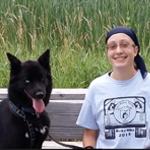How often does your dog refuse to do what you ask?
If you are like most people I have worked with, at some point you get frustrated with your dog. I have always owned Siberian Huskies and they are known for their independence and stubbornness. Some dogs love to please their owners, some dogs work for food or toys, and other dogs want to do what they want to do. I have one of the latter and he has taught me to let him make his own decisions about some things.
As an example, I have a friend that lives 1 mile away. When Riko and I visit her, I ask Riko how he would like to travel there: “Do you want to go for a ride?” Steady eye contact with no body movement. “Or a run?” Whine, whole body wag, followed by bark and sitting up.
“Or a walk?” Down into a sit, tail wag, and eye contact. With that information, it is clear which he preferred that day. Of course, you must factor in the things your dog cannot, such as weather and time restrictions. On a 95º day, I would not run or walk Riko and therefore would not give him the option to choose. As the owner, it is your duty to guide and protect your dog. You are responsible for knowing when to give your dog the freedom to choose.
Many dogs can benefit from being empowered to make their own decisions.
Since they do not want to work for you, confident and “stubborn” dogs will be more willing to work with you. Fearful and shy dogs will gain confidence as they are allowed to control what happens. “Do you want to let that person pet you?” All dogs will profit from the increased communication (imagine being able to communicate your wants in the same language as your family for the first time!).
Obviously, giving your dog the option to choose all the time, every time would not be training your dog.
Teaching your dog how to choose can be difficult. You are both learning a new skill and it may take time. Be patient! Start by teaching your dog the names of places or things. An easy first one may be the words “inside” and “outside.” In fact, your dog probably knows them already.
If your dog is prone to not coming inside when you call, try asking the next time you do not need him to come inside. “Inside?(give a pause for him to react) Or outside?” (Riko demonstrating his decision to stay outside: https://youtu.be/80Q4mzsFeew).When he doesn’t go to the door and want in, give him a pet and continue doing what you were. After enough repetitions, you will learn to understand each other. Be sure that your asking behavior is easily distinguished from your command to go inside otherwise your dog will become confused. When you cue your dog to go inside, say his name, motion, and give the command to go through the door.
Another idea for a choice to give your dog is the down command. When I need Riko to lie down in a specific place, I say, “Riko, down.” He immediately lays down. But there are times when I merely want him to settled down in the room I am in. It is not important where he chooses to rest. In those cases, I tell him, “Go lay down.” He then has 30 seconds to a minute to lay down before I tell him where to “down.”
By giving your dog the option to make decisions, you become a teammate and partner rather than a dictator.
Surprisingly, allowing Riko to choose has increased his obedience when I need him to obey. You have to find the correct balance for your dogs and your life but try giving them the chance to make choices. You may be surprised.
 Diane Petroski
Diane Petroski
The first dog I worked with was terrified of men and lacked many basic obedience skills. We worked together to build enough confidence and skills to become a therapy dog team. That sparked my love fortraining and I have been learning and training ever since. While I advocate for and train with positive methods, I read articles and books that cover a variety of methods. Being well-rounded and well-versedis important as it gives me a basis for addressing the variety of problems and dogs.
Since 2005, I have worked with dogs in their own homes. My work with dogs also includes training dogs at a local shelter and working with Siberian Husky rescues. At the local shelter, I trained the most difficult dogs, those marked with a red tag. The red tag indicated that the dog was dangerous in one way or another. My goal was to make those dogs adoptable or able to be pulled by rescues.
Feel free to visit my website and Facebook page:
www.dianethedogtrainer.com
www.facebook.com/dianethedogtrainer
























 Diane Petroski
Diane Petroski